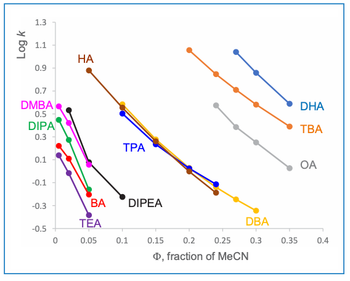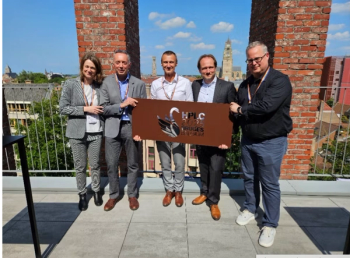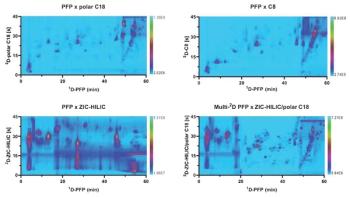
Innovations in Liquid Chromatography: 2025 HPLC Column and Accessories Review

Key Takeaways
- New LC columns focus on small-molecule RPLC, with advances in particle bonding and hardware technology enhancing peak shapes and column efficiency.
- Inert hardware trends continue, improving analyte recovery and reducing metal interactions, particularly for phosphorylated and metal-sensitive compounds.
The latest edition of "Column Watch" features our annual review of new liquid chromatography columns and accessories, introduced at Pittcon and other events over the past 12 months.
Our annual review of new liquid chromatography columns and accessories, introduced at Pittcon and other events over the past 12 months.
This article covers liquid chromatography (LC) columns and accessories commercially released after Pittcon 2024 through the 2025 conference. Each year, LCGC International sends out a survey asking vendors to supply information on products launched that fit the timeframe. Note that new products for gas chromatography, liquid chromatography instrumentation/software, and sample preparation are covered elsewhere. Information for this article is obtained over the course of many months, and it is possible that some information could have been missed or misinterpreted. The reader is encouraged to check with specific vendor sites for additional product releases as well as more detailed information on product usage and attributes.
The vendors that responded to the survey and their new LC products are listed in Table I. The products are classified, in general, according to the mode of chromatography they are intended for. The largest category can be broadly classified as small-molecule reversed-phase liquid chromatography (RPLC) columns. Continuing a trend observed for the past several years, within this category is a subset of columns utilizing inert hardware. Also, similar to the recent past, several products have been designed specifically for the separation of oligonucleotides, warranting a separate category. Other modes of separation include size-exclusion chromatography (SEC), ion-exchange (IEX) chromatography, hydrophilic interaction liquid chromatography (HILIC), and chiral chromatography. New columns based on a porous graphitic carbon support are reported as well as a highly application-specific column. No information on new accessories was obtained this year.
It is highlighted here that many of the new products may be classified in multiple categories and the information included in this article is provided by the responding vendors with only slight modifications for the sake of flow and readability.
Small Molecule Reversed-Phase Columns
The development of new columns for the purpose of separating small molecules, including peptides, continues to take place. For the past several years, this category has consistently witnessed the most entrants. The majority of the columns in this category are centered around modern particle bonding, and hardware technology. These advances enhance peak shapes for difficult molecules, improve column efficiency, extend the usable pH range, and provide improved and alternative selectivity. Also noted are some columns that are now provided in capillary format and a separate subcategory focused on the products using inert hardware to improve analyses of compounds that tend to detrimentally interact with metal surfaces.
Advanced Materials Technology has introduced the Halo 90 Å PCS Phenyl- Hexyl, a superficially porous reversed-phase chromatography column based on fused-core silica particles. This stationary phase features a phenyl-hexyl functional group and is optimized for mass spectrometry applications using formic acid or other low ionic strength mobile phases. This column provides enhanced peak shape and loading capacity for basic compounds and provides alternative selectivity to C18 phases, with no adverse effects on acidic or neutral analytes. The company also offers the Halo 120 Å Elevate C18 column, a superficially porous, hybrid particle reversed-phase liquid chromatography (RPLC) column built for high pH- and high-temperature stability. Designed for robust method development, it handles a wide pH range (2–12) and excels with basic compounds, making it highly suitable for diverse analyte types. The column's key benefits include improved peak shape, retention, and load tolerance, especially under aggressive high-pH conditions.
ChromaNik Technologies Inc. manufactures the SunBridge C18, an RPLC column. The main attributes of this stationary phase include high pH stability, spherical particles with a particle size of 5 μm, and a pore size of 150 Å. These columns are designed for general-purpose use and can operate under pH conditions ranging from 1 to 12. The key benefit is the high pH stability, which offers a broader range of applications compared to other columns.
Fortis Technologies Ltd. offers the Evosphere C18/AR RPLC column, which features monodisperse fully porous particles (MFPP) that offer higher efficiency compared to conventional products. The column is designed with C18 and aromatic ligands, with 17% phase coverage. This column is particularly suited for the separation of oligonucleotides without the need for ion-pairing (IP) reagents, making it a valuable tool for chromatographers. The product is available in different particle sizes (1.7 μm, 3μm, and 5 μm) and pore sizes of 100 Å, with various column dimensions available for analytical, capillary, and preparative applications.
Horizon Chromatography Limited offers the Aurashell Biphenyl column, an RPLC product built on superficially porous silica particles. With biphenyl functional groups and a combination of separation mechanisms (hydrophobic, π–π, dipole, steric), the product is well-suited for metabolomics, polar/non-polar compound analysis, and isomer separations. It delivers enhanced polar selectivity, is 100% aqueous compatible, and offers superior retention of hydrophilic aromatics, making it a valuable tool for advanced chromatographic applications.
Merck Life Sciences KGaA (MilliporeSigma in the US and Canada) offers the Ascentis Express and BIOshell A160 Peptide PCS-C18 columns, which feature a superficially porous particle design with a positively charged surface. These columns are beneficial for basic compounds, peptides, and pharmaceuticals, enhancing peak shapes and offering alternative selectivity compared to other C18 phases. They provide high throughput, excellent peak symmetry, and suitability for peptide mapping, with various column sizes and the capability for efficient high-flow-rate operation. Merck also launched Purospher STAR RP-18 endcapped capillary columns. With applications in proteomics, lipidomics, and other fields, the advanced chromatography tools offer high sensitivity, reduced sample volume, and lower solvent usage. The columns provide enhanced reproducibility, making them ideal for high-throughput and high-resolution analyses.
Restek Corporation now supplies the Raptor C8 LC Columns and Guards, designed for RPLC. These columns are made from superficially porous silica particles, featuring a C8 (octylsilane, L7) functional group, with a particle size of 2.7 μm and a pore size of 90 Å. Available in multiple dimensions, they are end-capped and spherically shaped with 4.6% carbon coverage. The Raptor C8 columns are suitable for a wide range of compounds from acidic to slightly basic and offer the benefit of faster analysis times with similar selectivity to C18 columns.
Biocompatible/Inert Columns
Columns made with inert hardware, often referred to as biocompatible or bioinert columns, continue to reach the market. This trend has been noted for several years.
Advanced Materials Technology offers a product called Halo Inert, an RPLC column that integrates passivated hardware to create a metal-free barrier between the sample and the stainless-steel . This feature is particularly advantageous for phosphorylated compounds and metal-sensitive analytes because it helps to prevent adsorption to metal surfaces. The main benefits of Halo Inert include enhanced peak shape and improved analyte recovery, making it especially useful in applications requiring minimal metal interaction.
Fortis Technologies Ltd. manufactures the Evosphere Max chromatography columns, which use inert hardware to enhance peptide recovery and sensitivity. These columns are made with monodisperse porous silica particles and come in three different particle sizes (1.7 μm, 3 μm, and 5 μm) with a 100-Å pore size. They are designed for use in various chromatography applications, providing improved performance over traditional products, particularly for metal-chelating compounds.
Restek Corporation launched the Restek Inert HPLC Columns, which are designed for RPLC. These columns are built on totally porous, conventional silica particles with polar-embedded alkyl (L68) and modified C18 (L1) stationary phases. Available in 3-μm and 5-μm particle sizes with a 100-Å pore size, they are spherical in shape and come in various dimensions. The products are particularly suited for the analysis of chelating PFAS and pesticide compounds, offering improved response for metal-sensitive analytes. A key feature of these columns is the use of inert hardware, enhancing performance by minimizing unwanted interactions. Restek Corporation also offers their Force Inert HPLC Guard Column Cartridges. These columns are based on totally porous, conventional silica particles and feature biphenyl and C18 functional groups. They are designed with 5-μm particle size and 100-Å pore size and are available in guard column dimensions of 5 x 2.1mm and 5 x 3.0 mm. The main benefits of these guard columns include protecting inert HPLC columns and enhancing the response of metal-sensitive compounds. Notably, the product features fully inert hardware, making it ideal for the analysis of chelating compounds. In addition, Restek Corporation introduced the Raptor Inert HPLC Guard Column Cartridges as a new product offering. These cartridges are based on superficially porous silica particles with a 2.7-μm particle size and a 90-Å pore size. Available in 5 x 2.1 mm and 5 x 3.0 mm guard formats, they feature functional groups including C18, ARC-18, biphenyl, and HILIC-Si. The key benefits include the protection of inert HPLC columns and improved response when analyzing metal-sensitive compounds. These guard columns are particularly suited for the analysis of chelating compounds. Lastly, Restek Corporation has introduced the Raptor Inert HPLC Columns, which are designed with superficially porous silica particles. These columns incorporate functional groups such as HILIC-Si, FluoroPhenyl, and Polar X and are available in particle sizes of 1.8 μm and 2.7 μm with a pore size of 90 Å. They feature a spherical particle shape and are available in various column dimensions. The key benefits are improved chromatographic response for metal-sensitive polar compounds. These columns are ideal for applications where metal interactions could otherwise degrade performance.
YMC, offers the YMC Accura BioPro IEX guard cartridges, which are ideal for applications involving oligonucleotides, antibodies, proteins, peptides, and liquid chromatography-mass spectrometry (LC– MS) analyses. These cartridges are made from polymethacrylate and feature bioinert properties, ensuring high performance chromatography. Key benefits include protecting the main column, exceptional recovery, superior reproducibility, and suitability for LC–MS analyses. The product’s spherical shape and non-porous nature contribute to its reliability and effectiveness in chromatographic workflows. The company also launched Accura Triart guard cartridges that are specialized chromatography columns designed for high-performance liquid chromatography. These cartridges are bioinert, providing exceptional protection for main columns, and are suitable for use with a pressure limit of 1000 bar. The product line boasts high coverage, high pH stability, and exceptional recovery without preconditioning, making it ideal for LC–MS analyses of oligonucleotides, antibodies, proteins, peptides, and other complex biomolecules. The cartridges feature a hybrid particle base material and come in various particle sizes (1.9 μm, 3 μm, and 5 μm) with pore sizes ranging from 80 to 300 Å. The bioinert coated stainless-steel construction adds rigidity and durability, ensuring superior reproducibility and preventing carry-over effects. These guard cartridges are particularly beneficial in protecting main columns from contamination and prolonging their lifespan.
Oligonucleotide-Specific Columns
Oligonucleotides and related compounds have been a major target for HPLC column manufacturers for the past several years. In a similar fashion to developments in small-molecule RPLC columns, modern particle technology, inert hardware, and advanced bonding and surface treatment procedures aim to improve the separation quality for this class of compounds.
Advanced Materials Technology offers the Halo 120 Å Oligo C18, an RPLC column engineered for oligonucleotide analysis. The column is based on superficially porous, hybrid silica particles with a dimethyloctadecylsilane functional group, and it operates at high pH, providing alkaline resistance and excellent sample recovery. Its inert hardware design minimizes adsorption, making it ideal for detecting closely related impurities and failure sequences in oligonucleotide samples.
Agilent Technologies introduced the AdvanceBio Oligonucleotide column, designed for oligonucleotide purification. This product features a superficially porous silica particle with a high pH compatible C18 functional group, offered in 2.7 μm and 4 μm particle sizes and a 120 Å pore size. Column dimensions include 10 x 50 mm, 10 x 100 mm, 10 x 150 mm, and 21.2 x 100 mm. The stationary phase is spherical in shape and is stable up to pH 11. Key benefits include high-resolution purification for optimal yield and purity at lower pressures, and the ability to perform semi-preparative purification using an analytical LC system.
Sielc Technologies offers a product called OligoMg, a cation-exchange chromatography column. The product is based on a silica stationary phase dynamically loaded with Mg²⁺ ions, featuring negatively charged groups for selective separation. OligoMg is available in dimensions such as 4.6 × 50–150 mm and 3.2 × 50–150 mm, with particle sizes of 2.1 μm and 3 μm and pore sizes of 100 Å and 300 Å. Its key attributes include superior separation of negatively charged and multi-charged molecules like oligonucleotides, innovative BIST technology for enhanced performance, and the ability to function with a simplified mobile phase of just water and acetonitrile (H₂O/MeCN). The column offers unique selectivity based on nucleobase type and number, making it ideal for the separation and purification of oligonucleotides, nucleic acid analysis, and selective retention of phosphorylated compounds.
Thermo Fisher Scientific’s DNAPac RP semi-preparative chromatography column is designed for oligonucleotide purifications, offering high resolution and versatility. This column is particularly effective for SiRNA, mRNA, and DNA separations. The column features a unique supermacroporous structure, ensuring stability under various pH and temperature conditions. The column's inert hardware and polymeric material contribute to better analyte interaction and higher purification yields.
Size-Exclusion Chromatography Columns
Size-exclusion chromatography (SEC) has become a crucial tool for the characterization of large molecule therapeutics and industrial polymer analysis and design. Improvements in the control of particle pore structure, surface chemistry and column hardware design have all contributed to new products in this important realm of chromatography.
Agilent Technologies introduced the AdvanceBio SEC 500 Å and 1000 Å columns, specifically designed for size exclusion chromatography (SEC). These columns are built using conventional porous silica particles with a 2.7-μm particle size and are available with pore sizes of 500 Å and 1000 Å. Key attributes include a hydrophilic polymer coating, high pore volume, and spherical particle shape. The main benefits for users are high-resolution, high-throughput separations, particularly for large biotherapeutics such as adeno-associated viruses (AAV), virus-like particles (VLPs), and oligonucleotides (ONs). The columns’ unique features include minimized secondary interactions, high resolution, and an extended column lifetime.
Phenomenex, Inc. has developed the Biozen dSEC-7 specialty column, ideal for SEC of large biomolecules such as AAVs. The column features a pore-controlled silica base, hydrophilic bonded surface chemistry, and a spherical particle shape. This column's key benefits include conserving sample volume, enabling faster analysis, and improving resolution. It also offers flexibility with mobile phase choices and is compatible with a wide range of LC instruments.
Thermo Fisher Scientific’s SurePac Bio 550 SEC MDi columns are designed for high-performance SEC, offering significant benefits in applications such as AAV analysis. Their advanced technology and bioinert construction make them highly reliable, reproducible, and ideal for gene therapeutic research.
Waters Corporation offers the Acquity and XBridge Premier 125 Å SEC Guards and columns, designed for high consistency in the analysis of biotherapeutic peptides and small proteins. Key attributes include 1.7-μm and 2.5-μm particle sizes, a 125-Å pore size, and spherical particles. The columns are tested for quality control with each batch, ensuring consistency and performance. The primary benefit is the outstanding batch-to-batch consistency, ideal for high-quality chromatographic analysis in biopharmaceutical research.
Ion-Exchange and Ion-Exclusion Chromatography Columns
Where analytes differ in their charge state or degree of ionization, ion-exchange is a powerful means of separation and is an indispensable tool for most practicing chromatographers. The columns released this year feature anion-exchange, cation-exchange, and cation-exclusion mechanisms.
Antec Scientific offers the SweetSep AEX200 and AEX20 columns, designed for ion chromatography. These products utilize highly monodisperse 5-μm ethylvinylbenzene-divinylbenzene copolymer particles, coated with latex nano beads and functionalized with quaternary (AEX200) or bifunctional quaternary/tertiary (AEX20) amine groups. Key attributes include high pH resistance (up to pH 14), spherical particle shape, and high ion-exchange capacities. The main benefits are up to three times higher sensitivity, four times less mobile phase use and waste generation (green chromatography), and maintained separation efficiency even with reduced column internal diameter. The columns are ideal for analyzing all classes of carbohydrates in food and beverage, biomass, and artificial sweetener applications. Additionally, Antec Scientific has expanded the SweetSep range to include 2.1-mm internal diameter (i.d) columns for even greener and more sensitive analyses.
Sielc Technologies has introduced the BIST A column, a silica-based cation-exchange product featuring a negatively charged surface and hydrophilic properties. Powered by proprietary BIST Technology, this column offers unique retention of multicharged molecules, superior peak shape and resolution, simplified method development without the need for extreme pH or high salt conditions, and enhanced reproducibility. Designed especially for the separation of nucleic acids and oligonucleotides, BIST A comes in a wide range of dimensions, uses spherical silica particles with 5-μm size, and is available with 100-Å and 300-Å pore sizes. The column requires a specially formulated mobile phase containing double-charged ions for optimal performance. Sielc Technologies also offers a new product called Lipak, a mixed-mode (reversed-phase and cation-exchange) column designed for advanced lipid separations. Lipak is based on a conventional silica particle with spherical shape, 3-μm or 5-μm particle size, and 100-Å pore size. It features an integrated reversed-phase functionality combined with negatively charged groups to allow simultaneous separation of diverse lipid classes. The product provides superior resolution for complex lipid mixtures, enhances lipidomics analysis, and has versatile applications for other fat-soluble compounds like vitamins, chlorophylls, and surfactants. It is available in various standard column dimensions and is particularly suited for researchers needing efficient and comprehensive lipid separation capabilities. In addition, the company has introduced the polyethyleneimine (PEI) column, designed specifically for cation-exclusion and size-exclusion chromatography. This product features a silica-based stationary phase with positively charged functional groups, using spherical particles of 5-μm size and 100-Å pore size in a 4.6 x 250 mm dimension format. The column is optimized for PEI characterization and analysis of other positively charged polymers, offering versatile mobile phase compatibility, improved reproducibility, and reliable peak shape with minimal peak tailing, making it a robust choice for accurate and consistent quantification.
Chiral Chromatography Columns
For the only chiral entries this year, ColumnTek LLC introduced the Enantiocel IDA and Enantiocel IDB. These columns feature immobilized amylose and cellulose tris(3,5-dimethylphenyl carbamate) functional groups and are available in both 3-μm and 5-μm particle sizes. The columns are primarily used in normal phase, reversed-phase, and supercritical fluid chromatography (SFC). Their spherical silica base material ensures high efficiency, resistance to various solvents, and enhanced enantioselectivity, making them highly compatible with a wide range of solvents. These attributes allow chromatographers to achieve improved results in enantioselective analysis, separation, and purification.
Hydrophilic Interaction Liquid Chromatography (HILIC) Columns
RPLC struggles to retain polar analytes and this is where HILIC chromatography finds a great deal of its utility. New columns in this category include line extensions using monodisperse silica particles, extended capillary hardware options, and a polymeric-based polar molecule solution.
Fortis Technologies Ltd has introduced the Evosphere HILIC chromatography column, designed for the retention of polar molecules, peptides, and proteins. The column utilizes monodisperse fully porous particles offering enhanced sensitivity and higher retention of polar molecules. Available in particle sizes of 1.7 μm, 3 μm, and 5 μm, the column provides superior chromatographic efficiency. The column's spherical shape and the use of conventional porous silica particles make it a versatile option for analytical and capillary column applications. Additionally, the column’s reduced A-term further boosts efficiency, making it a valuable tool for chromatographers.
Merck Life Sciences now offers the SeQuant ZIC-HILIC and ZIC-cHILIC capillary columns, which are designed for high-performance HILIC applications, particularly in biorelated fields such as proteomics, metabolomics, and glycomics. These columns feature zwitterionic stationary phases and modernized glass-lined capillary hardware, delivering superior reproducibility, stability, and performance. Key benefits include high loadability, LC–MS compatibility, and enhanced separation of polar hydrophilic compounds. They are an excellent choice for use in both standard and 2D-LC systems.
Shimadzu launched the Shim-pack Mix-HILIC column, a polymeric (polymethacrylate)-based specialty column designed for both anion-exchange and HILIC separation modes. It is especially beneficial for the analysis of hydrophilic metabolites such as amino acids, nucleobases, nucleosides, nucleotides, coenzymes, and organic acids in metabolomics studies. Key attributes include a 5-μm particle size, 150 mm x 2.1 mm dimensions, and a polyamine functional group. The main benefits are the ability to simultaneously analyze a wide variety of hydrophilic metabolic components without the need for ion-pair reagents, making it ideal for LC–MS/MS workflows. A unique feature is the dynamic functional group behavior with pH changes, allowing for effective separation of polar compounds that are challenging to retain with traditional alkyl or HILIC phases.
Porous Graphitic Carbon (PGC) Columns
Although silica-based stationary phases remain supreme, other supports continue to be developed and commercialized. The Supel Carbon LC 2.7-μm Capillary Column, by Merck Life Sciences, offers excellent temperature stability, pH resistance, and the ability to resolve a range of challenging compounds without the need for HILIC conditions. Its applications span various fields, including metabolomics, pharmaceutical analysis, food and environmental testing, and proteomics. The column’s high efficiency, resolution, and compatibility with various solvents make it a powerful tool for advanced analytical tasks.
Application Specific/Specialty Columns
Agilent Technologies offers the AdvanceBio Surfactant Profiling HPLC columns, designed for RPLC. These columns are made from totally porous conventional silica particles with a proprietary functional group, a particle size of 3.5 μm, and a wide pore size of 300 Å. Available in dimensions such as 2.1 x 50 mm to 2.1 x 150 mm and 4.6 x 50 mm plus guards, the columns are spherical in shape. They are primarily used for analyzing the degradation of non-ionic surfactants in biologic formulations. Key benefits include achieving high resolution of surfactant degradants in short run times, while notable features include stability up to 80 °C and enhanced mass transfer due to the wide pore size.
Conclusion
The HPLC column market has undergone another year of innovation, driven by the overlapping demands of speed, reproducibility, and selectivity. Reversed-phase columns remain dominant, but the variety of new stationary phases and hardware enhancements suggests a strong shift toward functionally specialized solutions. Trends observed in this review include the growing reliance on superficially porous and monodisperse particles for improved resolution and speed, the strategic use of inert hardware to reduce analyte interaction losses, and the development of niche columns for oligonucleotide and viral vector analysis. Additionally, several new products in capillary format suggests manufacturers are considering trends in green and sustainable analytical workflows.
About the Column Editor
Newsletter
Join the global community of analytical scientists who trust LCGC for insights on the latest techniques, trends, and expert solutions in chromatography.




